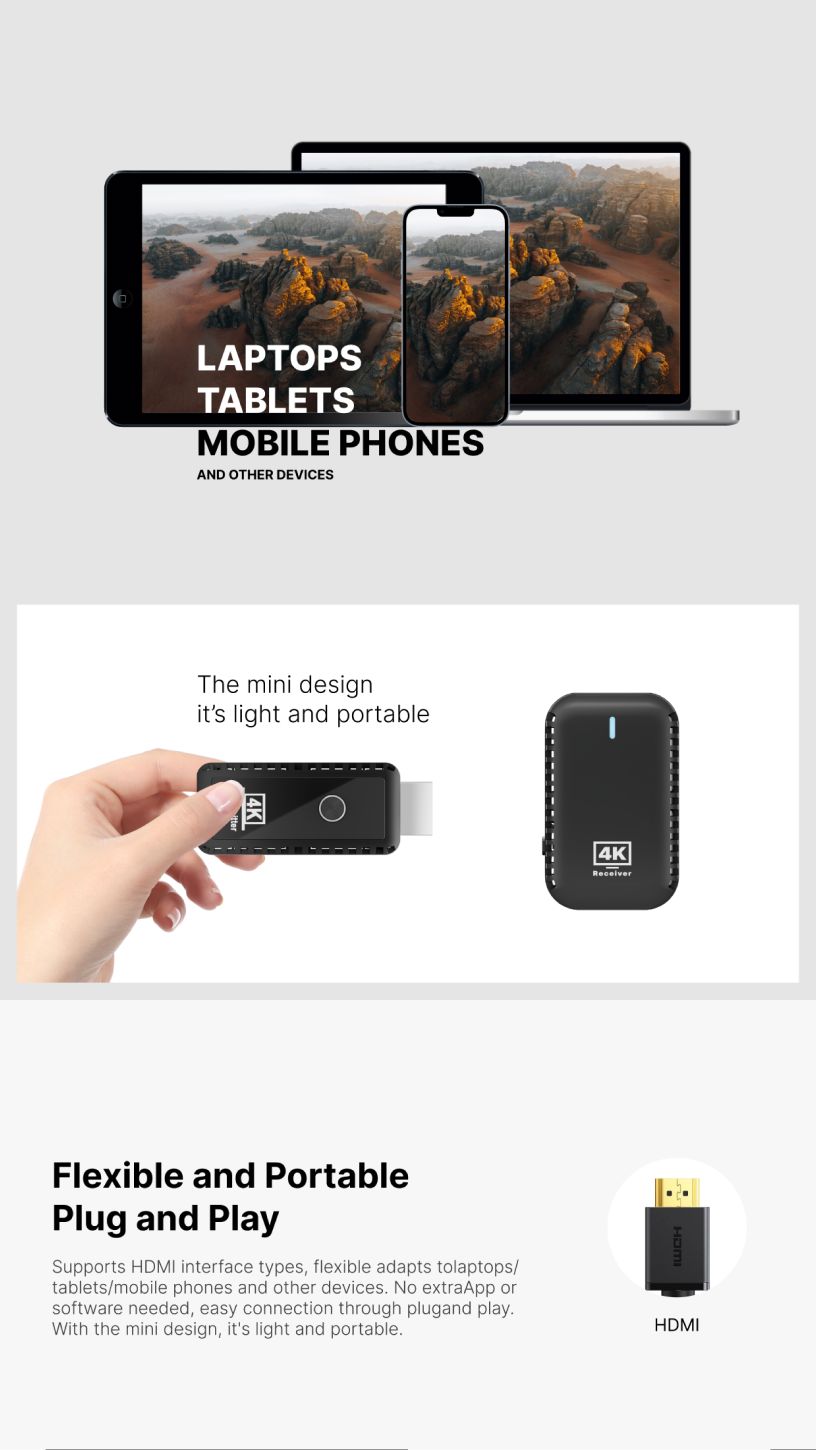How a Wireless HDMI Extender Works: Complete Technical Overview for Professional Users
Keywords: wireless HDMI extender, wireless HDMI transmitter and receiver, HDMI wireless solution, 4K HDMI extender
Introduction
In today’s commercial and home entertainment environments, reducing cable clutter and achieving flexible display setups are essential. A Wireless HDMI Extender provides a seamless solution by transmitting high-definition video and audio signals over the air — without any physical HDMI cable.
But how exactly does it work? This article explains the core working principle, structure, and technology behind wireless HDMI transmission, helping B2B users understand its value in professional applications.
What Is a Wireless HDMI Extender?
A wireless HDMI extender consists of a transmitter (TX) and a receiver (RX) that work together to send HDMI signals wirelessly using frequency bands such as 2.4GHz, 5GHz, 60GHz, or Wi-Fi 6. It enables the real-time transfer of uncompressed or compressed video and audio from a source device (like a computer, Blu-ray player, or camera) to a display device (such as a TV, monitor, or projector).
How Does a Wireless HDMI Transmitter and Receiver Work?
- Signal Input (Source to Transmitter): The transmitter receives HDMI video and audio signals from the source device through its HDMI input port.
- Signal Encoding and Compression: HDMI signals carry very high bandwidth (up to 12 Gbps for 4K/60Hz). The transmitter uses H.264, H.265 (HEVC), or MJPEG video compression to reduce the data rate to around 50–200 Mbps for efficient wireless transfer.
- Wireless Transmission: The encoded data is modulated and transmitted via radio frequency (RF) channels. Common wireless protocols include WHDI, HDbitT, Miracast, Wi-Fi Direct, or proprietary low-latency transmission standards.
- Reception and Decoding: The receiver’s RF module captures the wireless signal and demodulates it. The decoded HDMI signal is then reconstructed and output to the display device.
- Display Output: The video and audio appear on the connected screen in real time. Typical latency ranges from 30ms–200ms, depending on compression method and signal environment.
Core Technologies and Transmission Protocols
| Technology | Description | Application |
|---|---|---|
| WHDI | 5GHz band, uncompressed, ultra-low latency (<5ms) | High-end conference systems |
| HDbitT | H.264-based, strong anti-interference | Digital signage, video walls |
| WirelessHD (60GHz) | Extremely high bandwidth, short range (<10m) | VR and home theater |
| Wi-Fi Direct / Miracast | Wi-Fi standard-based, easy pairing | Consumer-grade wireless display |
| Wi-Fi 6 (802.11ax) | High-speed, low-latency new generation | 4K and 8K wireless HDMI transmission |
Key Performance Parameters
| Parameter | Description |
|---|---|
| Supported Resolution | Up to 4K@30Hz or 4K@60Hz |
| Transmission Range | 10–200 meters (depending on frequency and environment) |
| Latency | 30ms–200ms |
| Bandwidth | 50–200 Mbps |
| Pairing Method | Auto or manual pairing |
| Anti-Interference | FEC error correction, MIMO, automatic channel switching |
Advantages and Limitations
Advantages
- Plug-and-play installation with no cabling
- High-definition and stable wireless transmission
- Compatible with multiple HDMI devices
- Ideal for professional environments and multi-screen setups
Limitations
- Performance can be affected by walls and interference
- Slight signal delay at longer distances
- Higher cost compared to traditional HDMI cables
Typical Use Cases
| Scenario | Application |
|---|---|
| Conference Rooms | Wireless presentation from laptops to displays or projectors |
| Home Theater Systems | Streaming from Blu-ray players or set-top boxes to TVs |
| Exhibitions & Digital Signage | Wireless playback from a remote media player |
| Security Monitoring | Wireless video feed transmission from cameras to monitors |
| Education & Training | Screen sharing from teacher’s computer to smart board |
Summary
A wireless HDMI extender utilizes a combination of video compression, radio frequency transmission, and digital decoding to deliver HDMI video and audio signals without physical cables.
Thanks to advancements in Wi-Fi 6, H.265, and low-latency protocols, modern extenders can now deliver 4K/60Hz video quality with near-zero delay — making them a practical choice for business presentations, commercial displays, and home entertainment setups.
Call to Action
Looking for a reliable and high-performance wireless HDMI transmitter and receiver for your business or OEM/ODM project?
Contact Hoomc today to get a free consultation or customized solution for your application.




